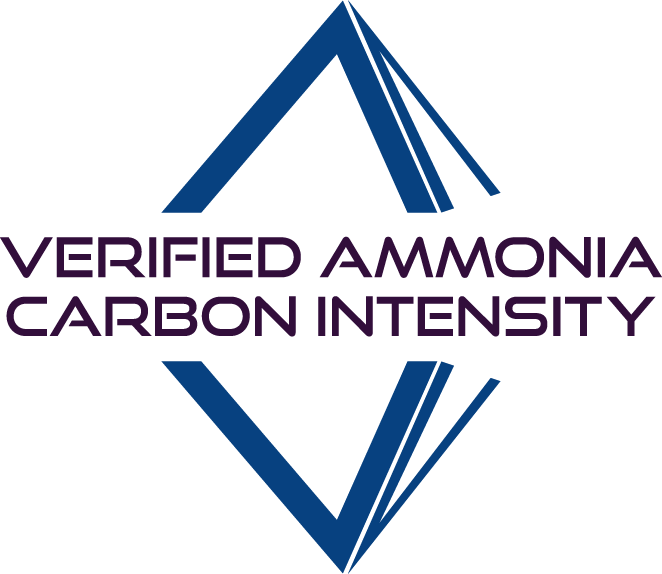GET CERTIFIED
Validate and verify your company’s efforts in emissions reduction related to the production of ammonia.
APPLY TO GET CERTIFIED
Once this form is completed, you will be sent a full application document along with payment method.
CERTIFIED FACILITIES
| Company | Facility | Contact | Date Approved |
| Nutrien | Geismar | December 16, 2024 | |
| Nutrien | Redwater | December 16, 2024 | |
| CF Industries | Donaldsonville (pre-production certification) | December 16, 2024 | |
| LSB Industries Inc. | El Dorado (pre-production certification) | jkrummenacher@lsbindustries.com | February 21, 2025 |
GET CERTIFIED FAQ
Who can apply?
Participation in the Verified Ammonia Carbon Intensity program is entirely voluntary, and all ammonia producers are eligible regardless of size, location, or TFI membership status. Ammonia production does not have to meet a certain carbon intensity level to apply. We believe this results in greater transparency.
Why choose Verified Ammonia Carbon Intensity?
Verified Ammonia Carbon Intensity allows for flexibility for the ammonia producer to be able to meet the requirements of individual customers.
How do I apply?
Auditing companies can apply for certification using the certification form.
- Ammonia producer (applicant) uses the Verified Ammonia Carbon Intensity methodology to calculate the carbon intensity of ammonia production at a certain facility for a duration of one year.
- Ammonia producer applies for certification of the facility using the online application.
- Ammonia producer selects an auditor from the approved auditor list and engages them to perform an audit of the facility and carbon intensity calculation.
- Verified Ammonia Carbon Intensity certifies the facility calculated the carbon intensity according to the methodology, based on the audit report findings.
How does the audit process work?
VACI-recognized auditors can be found here.
The facility is responsible for contacting the qualified auditor to schedule the date and time of the on-site assessment. The facility assumes all responsibilities for auditor fees and performance. Any changes to the types of assessments requested by the facility must be made with the auditor before the on-site assessment commences. Auditors must conduct all assessments requested in person and at the ammonia production facility. Applicants shall report to Verified Ammonia Carbon Intensity the status of the third-party assessment, such as audit company choice, schedule of audit assessment, missing evidence, identification of facility non-conformities, and other relevant audit activities.
Corrective Action Plan: Assessment audits may identify facility non-conformities, which shall be reported to the applicant facility. Corrective actions identify the issues and provide time frames in which such issues must be corrected to satisfy all applicable audit requirements. The facility shall provide evidence to the auditor that it has resolved either by providing documentary proof to the auditor’s satisfaction that non-conformity issues were corrected or by arranging for a follow-up on-site assessment to confirm that all non-conformity issues were corrected.
What is the cost to apply?
Verified Ammonia Carbon Intensity is open to all ammonia producers interested in becoming certified. The Fertilizer Institute (TFI) members receive a discounted Application Fee. To learn more about membership, visit TFI.org.
Application fee: $5,000 for members, $10,000 for non-members.
How frequently is each certification renewed?
Renewals shall occur on an anniversary basis. Six months before the expiration of the Verified Ammonia Carbon Intensity Certificate term, a certified facility shall contact a qualified auditor to request a renewal audit assessment. The facility shall make every effort to schedule its renewal before its expiration. Certified facilities meeting renewal assessments are awarded another one-year certificate term. New term expiration dates shall be one year from the preceding term expiration date.
Renewal Grace Period: Facilities may apply for a date extension of six months before their certificate expires. Expiration date extensions shall be at most three months. Applications must provide a reason for any extension request. Any extension request, other than for auditor scheduling must be approved by Verified Ammonia Carbon Intensity. Extensions for auditor schedules shall be automatically approved.
What does this certificate enable the producer to do?
Verified Ammonia Carbon Intensity allows producers to issue statements of verified carbon intensity for batches of ammonia produced, that includes the carbon intensity (CI) score and volume(metric tons – MT). In the future, the program will be extended to allow producers to issue verification statements for ammonia derivatives.
What are the limits of the claims that producers can make about the ammonia on the basis of being certified?
- The Verified Ammonia Carbon Intensity program is currently restricted to ammonia. Standard carbon intensity calculations for ammonia derivatives are under review, so any claims must be limited to ammonia in relation to the certification. This does not preclude producers from developing carbon intensity calculations of derivative products while the certification standard is under development.
- Verified Ammonia Carbon Intensity pre-certification (an option available to facilities prior to operation) allows a producer to generate issue statements of verified carbon intensity for up to one year after initial production. At that point, the producer must apply for full certification.
- Carbon intensity is calculated on a well-to-gate basis and does not include transportation and other downstream emissions. Producers cannot make claims related to downstream emissions in relation to the certification.
- Producers cannot make claims that their product is a low carbon product purely on the basis of being certified. The carbon intensity calculations that were verified or validated by the third-party auditor can be used to support that claim.
- Producers must have an internal registry that tracks inventory of low carbon ammonia, which is audited as part of the VACI program.
- VACI certificates measure the carbon intensity of a produced ton of ammonia, and therefore cannot be used as a carbon offset for voluntary carbon market.

